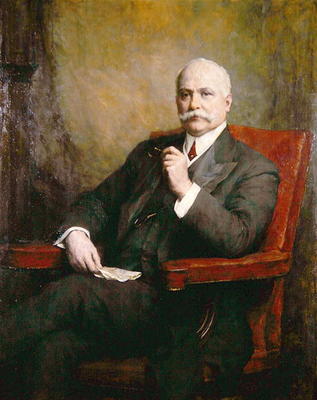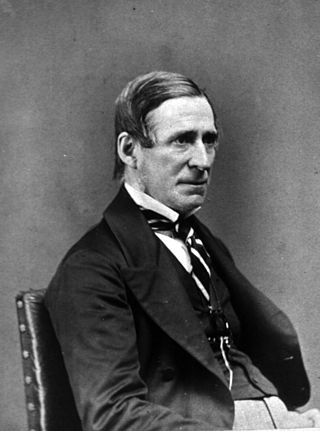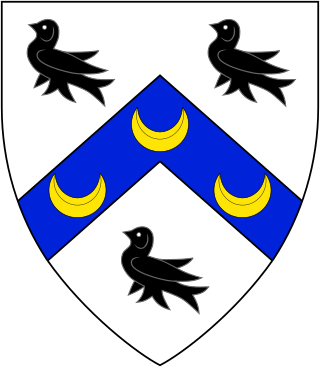Related Research Articles

Earl of Lonsdale is a title that has been created twice in British history, firstly in the Peerage of Great Britain in 1784, and then in the Peerage of the United Kingdom in 1807, both times for members of the Lowther family.
Baron Hayter, of Chislehurst in the County of Kent, is a title in the Peerage of the United Kingdom. It was created in 1927 for the businessman Sir George Chubb, 1st Baronet. He had already been created a baronet of Newlands in the Baronetage of the United Kingdom in 1900. Chubb was chairman and managing director of the firm Chubb and Sons Lock and Safe Co Ltd, established by his grandfather Charles Chubb in the early 19th century. "Hayter" was the maiden name of George Hayter Chubb's mother, and was selected in preference to "Chubb", as it was not considered appropriate for names of corporations to be attributed to members of the House of Lords. He was succeeded by his son, the second baron. He was managing director of Chubb and Sons Lock and Safe Co Ltd. His son, the third baron, was managing director and chairman of Chubb and Sons Lock and Safe Co Ltd and also served as deputy chairman of the House of Lords from 1981 to 1995. As of 2014 the titles are held by the latter's son, the fourth baron, who succeeded in 2003.
Baron Killearn, of Killearn in the County of Stirling, is a title in the Peerage of the United Kingdom. It was created in 1943 for the diplomat Sir Miles Lampson. He was the second son of Norman Lampson, youngest son of Sir Curtis Lampson, 1st Baronet, of Rowfant. Lord Killearn's eldest son, the second Baron, succeeded his second cousin once removed as fourth Baronet in 1971. On his death the titles passed to his half-brother, the third and present holder of the barony and baronetcy.

Baron Robertson of Oakridge, of Oakridge in the County of Gloucester, is a title in the Peerage of the United Kingdom. It was created on 29 June 1961 for the military commander Sir Brian Robertson, 2nd Baronet. He had previously served as Military Governor of the British Zone in occupied Germany from 1947 to 1949. The Robertson baronetcy, of Welbourn in the County of Lincoln, was created in the Baronetage of the United Kingdom on 4 October 1919 for his father, Field Marshal Sir William Robertson, Chief of the Imperial General Staff from 1915 to 1918. As of 2014 the titles are held by the first Baron's grandson, the third Baron, who succeeded his father in 2009.

There have been three baronetcies created for members of the Grey family, one in the Baronetage of England, one in the Baronetage of Great Britain and one in the Baronetage of the United Kingdom. Two of the creations are extant as of 2007.

There have been five baronetcies created for people with the surname Pollock, one in the Baronetage of Nova Scotia and four in the Baronetage of the United Kingdom. As of 2017 three of the creations are extant. These three creations derive from the same family to which the 1703 baronetcy was granted; the Pollock ancestor of Sir Frederick Pollock, 1st Baronet and Sir George Pollock, 1st Baronet married his cousin, daughter of Sir Robert Pollock, 2nd Baronet.

There have been three baronetcies created for persons with the surname Holden, all in the Baronetage of the United Kingdom. Two of the creations are extant as of 2010.
There have been three baronetcies created for persons with the surname Harvey, all in the Baronetage of the United Kingdom.
The Seely Baronetcy, of Sherwood Lodge in Arnold in the County of Nottingham and Brook House in Brooke on the Isle of Wight, is a title in the Baronetage of the United Kingdom. It was created on 19 February 1896 for the industrialist Charles Seely (1833–1915), son and namesake of Charles Seely (1803–1887). The first baronet's grandson, the third Baronet, was created Baron Sherwood, of Calverton in the County of Nottingham, in the Peerage of the United Kingdom in 1941. The peerage became extinct on his death, but he was succeeded in the baronetcy by his younger brother, the fourth Baronet. As of 2019, the title is held by the latter's grandson, the sixth baronet.
There have been four baronetcies created for members of the Harmsworth family, all in the Baronetage of the United Kingdom. All recipients were brothers.
There have been two baronetcies created for persons with the surname Bailey, both in the Baronetage of the United Kingdom. Both creations are extant as of 2010.
There have been four baronetcies created for people with the surname Samuel, all in the Baronetage of the United Kingdom. Two of the titles are still extant.
There have been two baronetcies created for persons with the surname Ewart, both in the Baronetage of the United Kingdom. One creation is extant as of 2010.
There have been two baronetcies created for persons with the surname Platt, both in the Baronetage of the United Kingdom. One creation is extinct while one is still extant.
There have been four baronetcies created for persons with the surname Hall, one in the Baronetage of Nova Scotia and three in the Baronetage of the United Kingdom. Three of the creations are extant as of 2010.

There have been three baronetcies created for persons with the surname Dixon, all in the Baronetage of the United Kingdom.

There have been three baronetcies created for persons with the surname Paget, all in the Baronetage of the United Kingdom, and a fourth created for the Bayly, which later became the Paget Baronetcy. As of 2016, two of the creations are extant.

There have been four baronetcies created for members of the Welsh Philipps family, one in the Baronetage of England and three in the Baronetage of the United Kingdom.
There have been two baronetcies created for members of the Vivian family, both in the Baronetage of the United Kingdom. Sir Hussey Vivian, created Baronet in 1828, was the uncle of Sir Henry Vivian, created Baronet in 1882. Both were later elevated to the peerage.

There have been seven baronetcies created for persons with the surname Watson, one in the Baronetage of England, one in the Baronetage of Great Britain and five in the Baronetage of the United Kingdom. One creation is extant as of 2016.
References
- ↑ "No. 27204". The London Gazette . 22 June 1900. p. 3891.
- ↑ "No. 31587". The London Gazette . 7 October 1919. p. 12418.
- Kidd, Charles, Williamson, David (editors). Debrett's Peerage and Baronetage (1990 edition). New York: St Martin's Press, 1990.
- Leigh Rayment's list of baronets